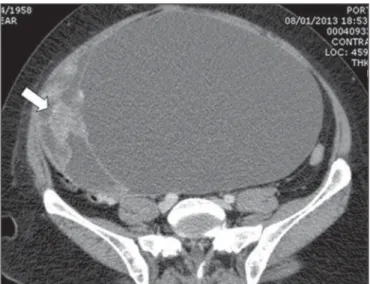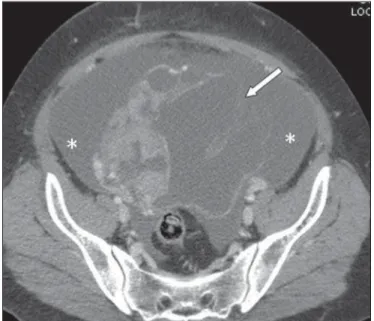Salvadori PS et al. / Spontaneous rupture of ovarian cystadenocarcinoma
Radiol Bras. 2015 Set/Out;48(5):330–332 330
0100-3984 © Colégio Brasileiro de Radiologia e Diagnóstico por Imagem
Case Report
Spontaneous rupture of ovarian cystadenocarcinoma:
pre- and post-rupture computed tomography evaluation
*
Ruptura espontânea de um cistoadenocarcinoma ovariano: avaliação tomográfica pré-e pós-ruptura
Salvadori PS, Bomfim LN, von Atzingen AC, D’Ippolito G. Spontaneous rupture of ovarian cystadenocarcinoma: pre- and post-rupture computed tomog-raphy evaluation. Radiol Bras. 2015 Set/Out;48(5):330–332.
Abstract
R e s u m o
Epithelial ovarian tumors are the most common malignant ovarian neoplasms and, in most cases, eventual rupture of such tumors is associated with a surgical procedure. The authors report the case of a 54-year-old woman who presented with spontaneous rupture of ovarian cystadenocarcinoma documented by computed tomography, both before and after the event. In such cases, a post-rupture staging tends to be less favorable, compromising the prognosis.
Keywords: Ovarian neoplasms; Serous cystadenocarcinoma; Spontaneous rupture.
Os tumores epiteliais correspondem à maioria das neoplasias ovarianas, sendo que eventuais rupturas estão mais relacionadas ao ato cirúrgico. Relatamos um caso de cistoadenocarcinoma ovariano em uma paciente de 54 anos com documentação tomográfica pré- e pós-ruptura espontânea. O estadiamento tumoral pós-ruptura tende a ser menos favorável, comprometendo o prognóstico desses pacientes.
Unitermos: Neoplasias ovarianas; Cistoadenocarcinoma seroso; Ruptura espontânea.
* Study developed at Department of Imaging Diagnosis – Escola Paulista de Medicina da Universidade Federal de São Paulo (EPM-Unifesp), São Paulo, SP, Bra-zil.
1. Master, MD, Radiologist, Department of Imaging Diagnosis – Escola Paulista de Medicina da Universidade Federal de São Paulo (EPM-Unifesp), São Paulo, SP, Bra-zil.
2. MD, Radiology Residency Preceptor at Hospital da Agro-Indústria do Açúcar e do Álcool de Alagoas, Professor of Imaging Sciences, Universidade Tiradentes (Unit), Maceió, AL, Brazil.
3. PhD, MD, Radiologist, Department of Imaging Diagnosis – Escola Paulista de Medicina da Universidade Federal de São Paulo (EPM-Unifesp), São Paulo, SP, Asso-ciate Professor at Universidade Federal de Alfenas (Unifal), Alfenas, MG, Post-gradu-ation Professor at Universidade do Vale do Sapucai´ (Univa´s), Pouso Alegre, MG, Brazil.
4. Private Docent, Associate Professor, Department of Imaging Diagnosis – Escola Paulista de Medicina da Universidade Federal de São Paulo (EPM-Unifesp), São Paulo, SP, Brazil.
Mailing Address: Dra. Priscila Silveira Salvadori. Departamento de Diagnóstico por Imagem – EPM-Unifesp. Rua Napoleão de Barros, 800, Vila Clementino. São Paulo, SP, Brazil, 04024-002. E-mail: pri_ss@hotmail.com.
Received June 28, 2013. Accepted after revision February 14, 2014.
of spontaneous rupture of ovarian serous cystadenocarcinoma documented by computed tomography both before and af-ter the event.
CASE REPORT
A 54-year-old woman attended the emergency depart-ment presenting with sudden-onset dyspnea associated with pain and increased abdominal volume. Chest computed to-mography (CT) demonstrated the presence of pulmonary thromboembolism (PTE). Abdominal CT showed a large pelvic solid-cystic mass with gross septations and solid com-ponent, compatible with epithelial ovarian tumor (Figure 1).
Priscila Silveira Salvadori1, Lucas Novais Bomfim2, Augusto Castelli von Atzingen3, Giuseppe D’Ippolito4
http://dx.doi.org/10.1590/0100-3984.2013.1844
INTRODUCTION
Epithelial ovarian tumors correspond to the most lethal malignant neoplasia of the female genital tract. Mucinous and serous tumors are the two most common types of epi-thelial neoplasia(1). Most commonly, rupture of ovarian
cys-tadenocarcinoma is associated with surgical manipulation(2),
significantly changing the staging and prognosis of the pa-tients.
Few reports are found in the literature about spontane-ous rupture of ovarian cystadenocarcinoma and these reports are mainly regarding pregnant women(3–5) and patients
us-ing anticoagulant drugs(6). The authors report the first case
Salvadori PS et al. / Spontaneous rupture of ovarian cystadenocarcinoma
Radiol Bras. 2015 Set/Out;48(5):330–332 331
The patient was admitted for treatment of the PTE, us-ing heparin and, at the ninth day after the admission, she pre-sented a sudden worsening in her condition with abdominal pain and a 3 g/dL drop in hemoglobin levels. A new abdomi-nal CT revealed a voluminous ascites and reduction in the dimensions of the adnexal solid-cystic mass with parietal dis-continuity, compatible with spontaneous rupture (Figure 2). The patient was submitted to exploratory laparotomy that revealed a great amount of hematic ascites and an adnexal tumor with solid component and ruptured cystic area (Fig-ure 3). Anatomopathological analysis characterized high-grade serous carcinoma.
DISCUSSION
The most recent Brazilian population data analysis in-dicates a risk for ovarian cancer corresponding to 6 cases/ 100,000 women. The main risk factors for development of ovarian cancer include family or personal history of breast or ovarian cancer; post-menopausal hormone replacement therapy, smoking and obesity(7). Epithelial ovarian tumors
correspond to 60% of all ovarian neoplasms and 85% of the malignant ovarian neoplasias(1).
Some of these tumors may present complications such as rupture, torsion, hemorrhage(3) or metastasis(8). Such
tu-mors rupture is frequently reported as occurring intraopera-tively in cases where a large lesion is attached to adjacent organs(2). Spontaneous rupture rarely occurs, generally as a
result either from internal tumor bleeding or from increased intralesional pressure in association with some risk fac-tor(3,4,6), such as anticoagulant therapies. A previous study
reports spontaneous rupture of an ovarian cystadenocarci-noma in a patient with congestive heart failure and under-going treatment with heparin who progressed with hemo-peritoneum, characterized by the presence of hyperdense (65– 70 Hounsfield units) fluid in the peritoneal cavity, but with-out clearly demonstrate the tumor lesion, probably because the scan was performed without using an intravenous con-trast agent(6). In the other cases described in the literature,
imaging studies were not performed.
In the present case, the tumor lesion was clearly identi-fied at the initial examination, presenting a sharp change in shape and reduction of dimensions at the subsequent scan, associated with the presence of ascites, which has allowed for establishing the diagnosis of tumor rupture, corroborated by the drop of hemoglobin levels resulting from the use of heparin due to the previous history of PTE. Heparin inhib-its the Xa factor and thrombin, blocking the coagulation cascade at these levels with therapeutical purposes; hemor-rhage is the main complication(9). The authors believe that
the heparin anticoagulation must have been responsible for a bleeding within the cyst, leading to increased intralesional pressure and subsequent rupture with hemoperitoneum.
Thus, the authors call the attention to the fact that the use of anticoagulant drugs in patients with voluminous cys-tic lesions must be done cautiously, taking the risk/benefit balance into consideration, with careful follow-up (by ultra-sonography, CT or magnetic resonance imaging) along the treatment for evaluation of possible severe complications, like in the present case. Additionally, the extravasation of the cystic content may result in intraperitoneal malignant cells dissemination, modifying the staging, the approach to be adopted and the prognosis of the patient(1).
REFERENCES
1. Jeong YY, Outwater EK, Kang HK. Imaging evaluation of ovarian masses. Radiographics. 2000;20:1445–70.
2. Mizuno M, Kikkawa F, Shibata K, et al. Long-term prognosis of stage I ovarian carcinoma. Prognostic importance of intraoperative rupture. Oncology. 2003;65:29–36.
Figure 2. Reduction in dimensions of the cystic mass, parietal discontinuity (ar-row) and voluminous ascites that was not identified at the previous study (aster-isks) performed eight days ago.
Salvadori PS et al. / Spontaneous rupture of ovarian cystadenocarcinoma
Radiol Bras. 2015 Set/Out;48(5):330–332 332
3. Malhotra N, Sumana G, Singh A, et al. Rupture of a malignant ova-rian tumor in pregnancy presenting as acute abdomen. Arch Gynecol Obstet. 2010;281:959–61.
4. Mladenovic-Segedi L, Mandic A, Segedi D, et al. Spontaneous rup-ture of malignant ovarian cyst in 8-gestation-week pregnancy – a case report and literature review. Arch Oncol. 2011;19:39–41. 5. Daro A, Carey CM, Zummo BP. Spontaneous rupture of a primary
carcinoma of the ovary complicating pregnancy. Am J Obstet Gynecol. 1949;57:1011–3.
6. Casal Rodriguez AX, Sanchez Trigo S, Ferreira Gonzalez L, et al. Hemoperitoneum due to spontaneous rupture of ovarian adenocar-cinoma. Emerg Radiol. 2011;18:267–9.
7. Brasil. Ministério da Saúde. Instituto Nacional de Câncer José Alen-car Gomes da Silva. Estimativa 2012: incidência de câncer no Brasil. Rio de Janeiro, RJ: INCA; 2011.
8. Moreira BL, Lima ENP, Bitencourt AGV, et al. Breast metastasis from ovarian carcinoma: a case report and literature review. Radiol Bras. 2012;45:123–5.

